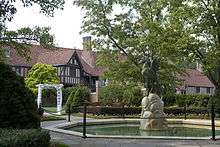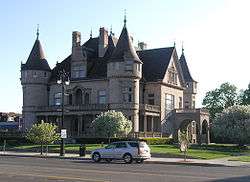Meadow Brook Hall
|
Meadow Brook Farms | |
|
Estate of Matilda Dodge Wilson | |
 Location within the state of Michigan  Meadow Brook Hall (the US) | |
| Location |
350 Estate Drive Rochester Hills, Michigan |
|---|---|
| Coordinates | 42°40′19″N 83°12′04″W / 42.67194°N 83.20111°WCoordinates: 42°40′19″N 83°12′04″W / 42.67194°N 83.20111°W |
| Built | 1926–1929 |
| Architect |
William E. Kapp Smith, Hinchman & Grylls |
| Architectural style | Tudor Revival |
| NRHP reference # | 79001166[1] |
| Significant dates | |
| Added to NRHP | April 17, 1979 |
| Designated NHL | March 2, 2012[2] |
| Designated MSHS | November 3, 1976 |
Meadow Brook Hall is a Tudor revival style mansion located at 480 South Adams Road in Rochester Hills, Michigan. It was built between 1926 and 1929 by Matilda Dodge Wilson (the widow of auto pioneer John Francis Dodge) and her second husband, lumber broker Alfred G. Wilson. In 1957, the mansion and the surrounding property and buildings were donated to the State of Michigan in order to fund Michigan State University–Oakland, now known as Oakland University. In 2012, it was named a National Historic Landmark.[2][3]
History
Meadow Brook Farms originally belonged to Matilda's first husband, automotive tycoon John F. Dodge. He purchased the property along with the large white farmhouse off of Adams Road as a holiday retreat for his family. The mansion is located on a 1,443-acre (5.84 km2) estate off South Adams Road; Dodge added a nine-hole golf course, some of the holes of which still follow the current Katke-Cousins 18-hole course on the property. Meadow Brook Hall was constructed between 1926 and 1929 by Matilda Dodge Wilson and her second husband, Alfred Wilson at a cost of $4 million.[4] Throughout her lifetime, Matilda resided in the hall for over forty years. Some of the family's time was spent vacationing at their summer home in Bar Harbor, Maine and winter home in Scottsdale, Arizona. The hall was also partially closed for a brief time during the depth of the Depression.[5]

Covering 88,000 square feet (8,200 m2) and with 110 rooms,[6][7] the mansion is the fourth largest historic house museum in the United States.[8] It was designed by William Kapp of the firm Smith, Hinchman & Grylls in a Tudor-revival style.[9] The building features stonework and a plaster dining room ceiling created by Corrado Parducci.[8] Much of the original artwork collected by the Wilsons is still found at Meadow Brook including paintings by Anthony van Dyck, Rosa Bonheur, Joshua Reynolds, John Constable and Thomas Gainsborough, as well as Tiffany glass, Stickley furniture, Meissen porcelain, and Rookwood pottery.[10] The estate was added to the National Register of Historic Places in 1979 and National Historic Landmark in 2012.[11][8]
In 1957, Alfred and Matilda Dodge Wilson donated the 1,500 acre estate to Michigan State University, along with $2 million to create a branch college campus, now known as Oakland University.[8] The Wilsons lived in the on the property until Alfred's death in 1962. Mrs. Wilson lived in Meadow Brook Hall until her death in 1967.[8]
Concours d'Elegance
The Meadow Brook Concours d'Elegance was held annually during August on the grounds of Meadow Brook Hall from 1979 until 2010.[12] This week-long event was one of the largest collector car shows in the world, and a social event in the tradition of the first Concours in 1920s Paris which was an exhibition of automotive design, craftsmanship, history and a tool for automobile manufacturers to market products.[12] Over the years, the event also served as a fundraiser for the preservation of Meadow Brook Hall.[13]
On July 20, 2010, promoters announced that the Concours d'Elegance would leave Meadow Brook Hall after that year for the Inn at St. John's in Plymouth, Michigan.[14] The event is now known at the Concours d'Elegance of America at St. John's.[15]
See also
References
- Inline
- ↑ National Park Service (2010-07-09). "National Register Information System". National Register of Historic Places. National Park Service.
- 1 2 "National Register of Historic Places Listings". www.nps.gov.
- ↑ "National Historic Landmarks: 13 New Sites Designated". Huffington Post. 7 March 2012. Retrieved 2012-04-14.
- ↑ Lavey, Kathleen (7 January 2016). "Check out these 5 Michigan castles". Times Herald. Port Huron, Michigan. Retrieved 24 August 2018.
- ↑ Colman, Justin (6 March 2012). "Meadow Brook Hall receives national landmark recognition". The Oakland Post. Retrieved 24 August 2018.
- ↑ "Welcome Mat: Meadow Brook Hall's Holiday Walk". The Detroit News. 17 November 2016.
- ↑ "Meadow Brook Hall History - Rochester, MI". meadowbrookhall.org.
- 1 2 3 4 5 Moutzalias, Tanya (28 October 2015). "Inside Meadow Brook Hall, the historic estate of one of the world's wealthiest women of her time". MLive. Retrieved 24 August 2018.
- ↑ Tate, Robert (16 June 2017). "Meadow Brook Hall Looks Back to Automotive Elegance". Motor Cities. Retrieved 24 August 2018.
- ↑ Pollack, Susan (1 September 2015). "Historic Auto Baron Home Tours to Check Out". Experience Michigan Magazine. Retrieved 24 August 2018.
- ↑ "Meadow Brook Hall". The Historical Marker Database. Retrieved 24 August 2018.
- 1 2 "Concours". ConcoursUSA. Retrieved 2011-03-18.
- ↑ "Frequently Asked Questions". Meadow Brook Hall Concours d'Elegance. 2003. Retrieved 2011-03-18.
- ↑ Edsall, Larry (July 30, 2010). "Detroit's Concours d'Élégance of America to Leave Meadow Brook". The New York Times. nytimes.com. Retrieved 2010-10-25.
- ↑ Hart, Roger (August 22, 2011). "Elegance Endures". AutoWeek. 61 (17): 38. ISSN 0192-9674.
- General
- A&E with Richard Guy Wilson, Ph.D.,(2000). America's Castles: The Auto Baron Estates, A&E Television Network.
- Kvaran, Einar Einarsson, Shadowing Parducci, unpublished manuscript.
- Wilson, Matilda Rausch Dodge, Debbie Patrick, ed., (1998). A Place in the Country: Matilda Wilson's Personal Guidebook to Meadow Brook Hall, Rochester, MI: Oakland University Press.
External links

- Official website

